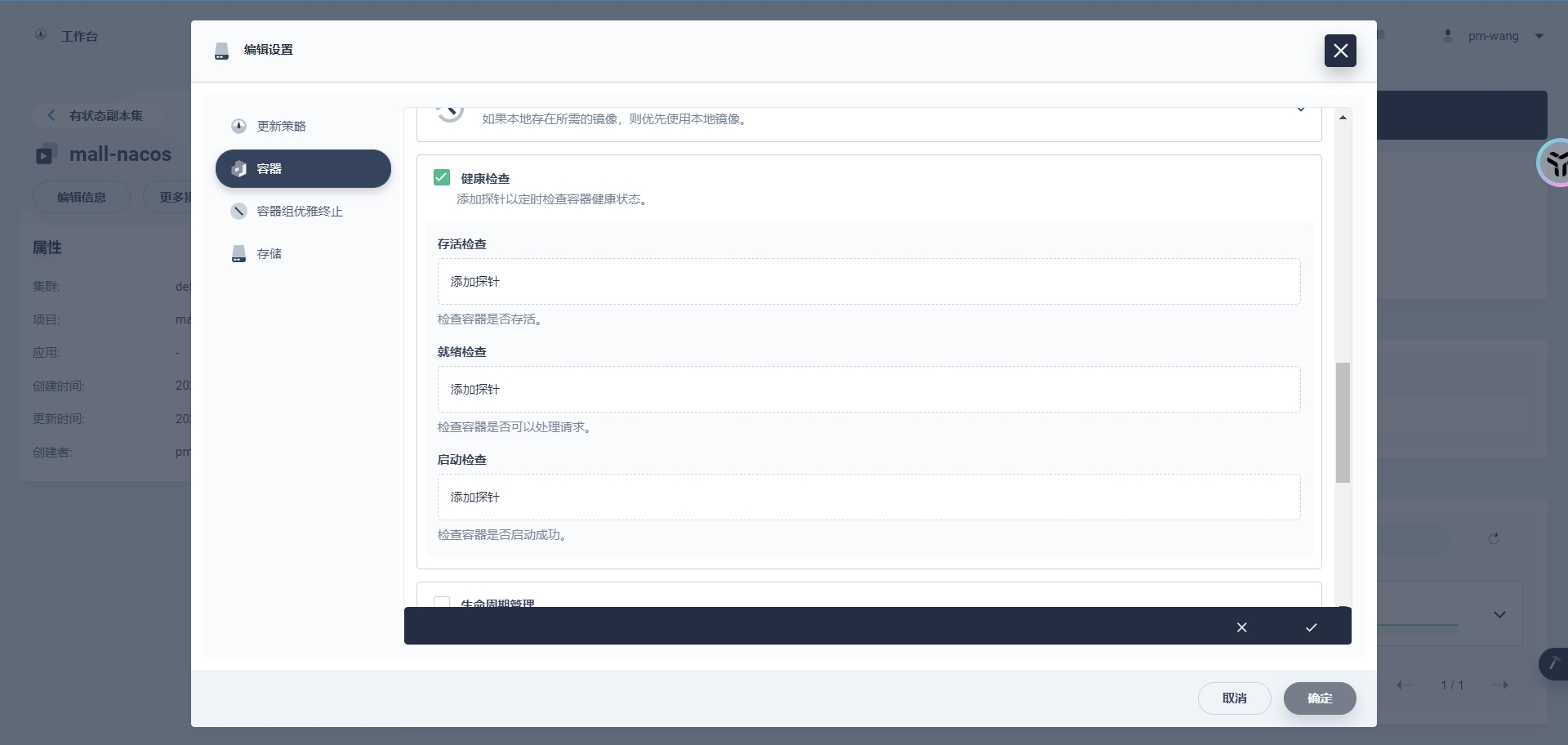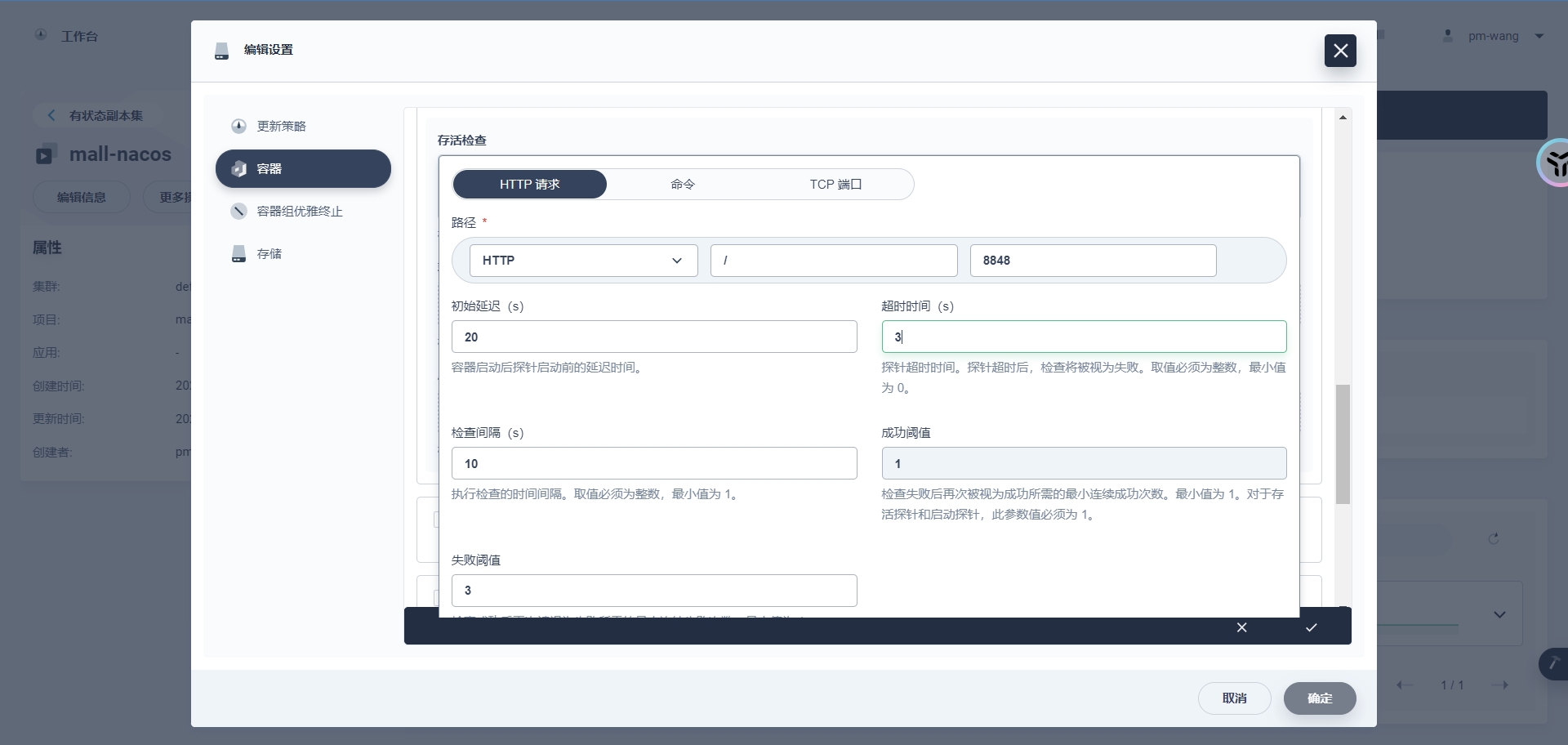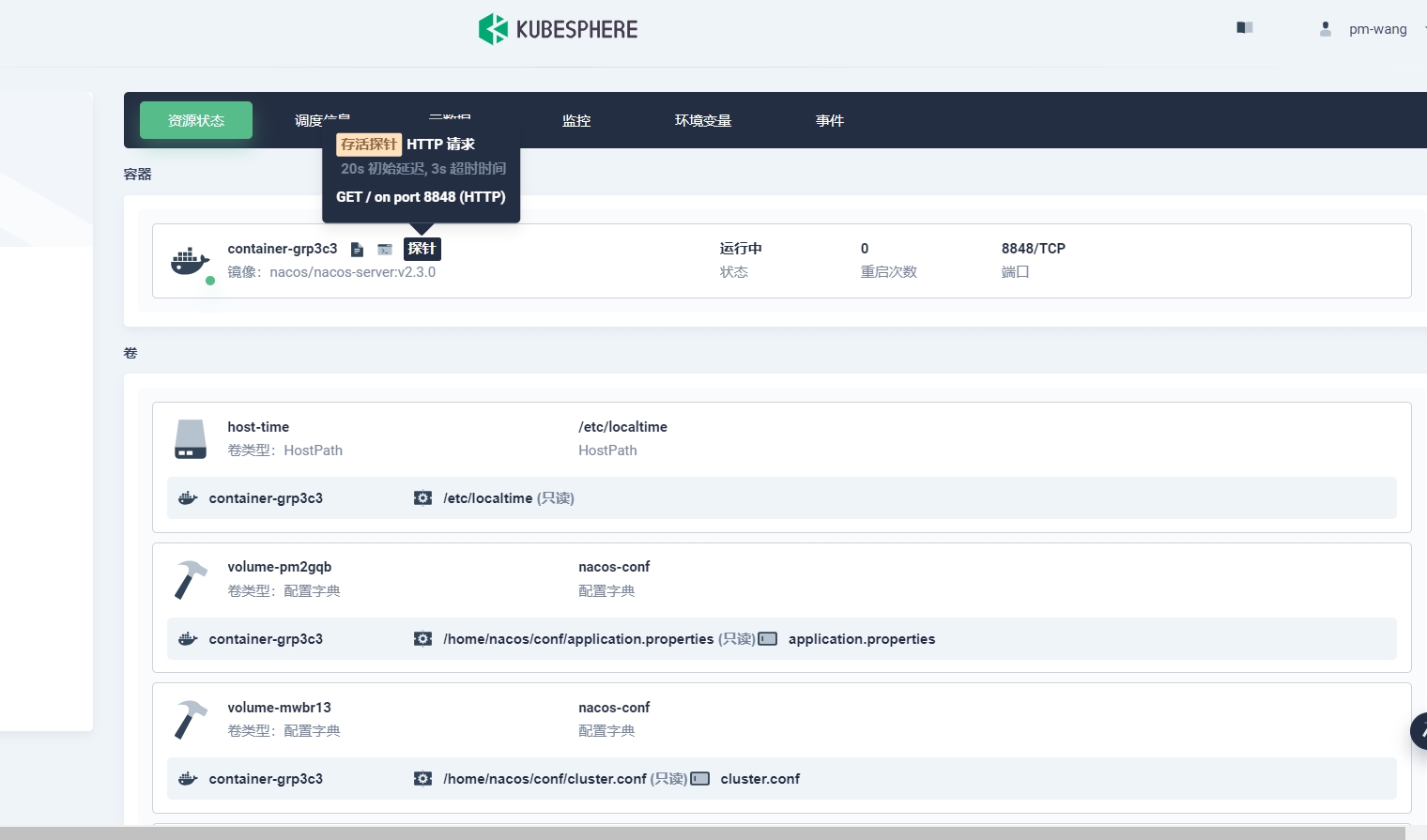kubesphere 入门
多租户
中间件部署
部署三要素
应用部署需要关注的信息【应用部署三要素】
- 应用的部署方式
- 应用的数据挂载(数据,配置文件)
- 应用的可访问性
- 有状态副本集 - Deployment(中间件)
- 无状态副本集 - StatefulSet (微服务)
- 守护进程 - DaemonSet (日志采集)
若依框架上云部署
1、有状态副本集部署(mysql,redis,nacos)
MYSQL
1、创建ConfigMap(也就是配置文件)
[client]
default-character-set=utf8mb4
[mysql]
default-character-set=utf8mb4
[mysqld]
init_connect='SET collation_connection = utf8mb4_unicode_ci'
init_connect='SET NAMES utf8mb4'
character-set-server=utf8mb4
collation-server=utf8mb4_unicode_ci
skip-character-set-client-handshake2、创建持久卷申明
持久卷声明定义了存储需求,系统根据持久卷声明创建持久卷
3、创建持久卷
持久卷定义了存储资源,系统根据持久卷创建持久卷 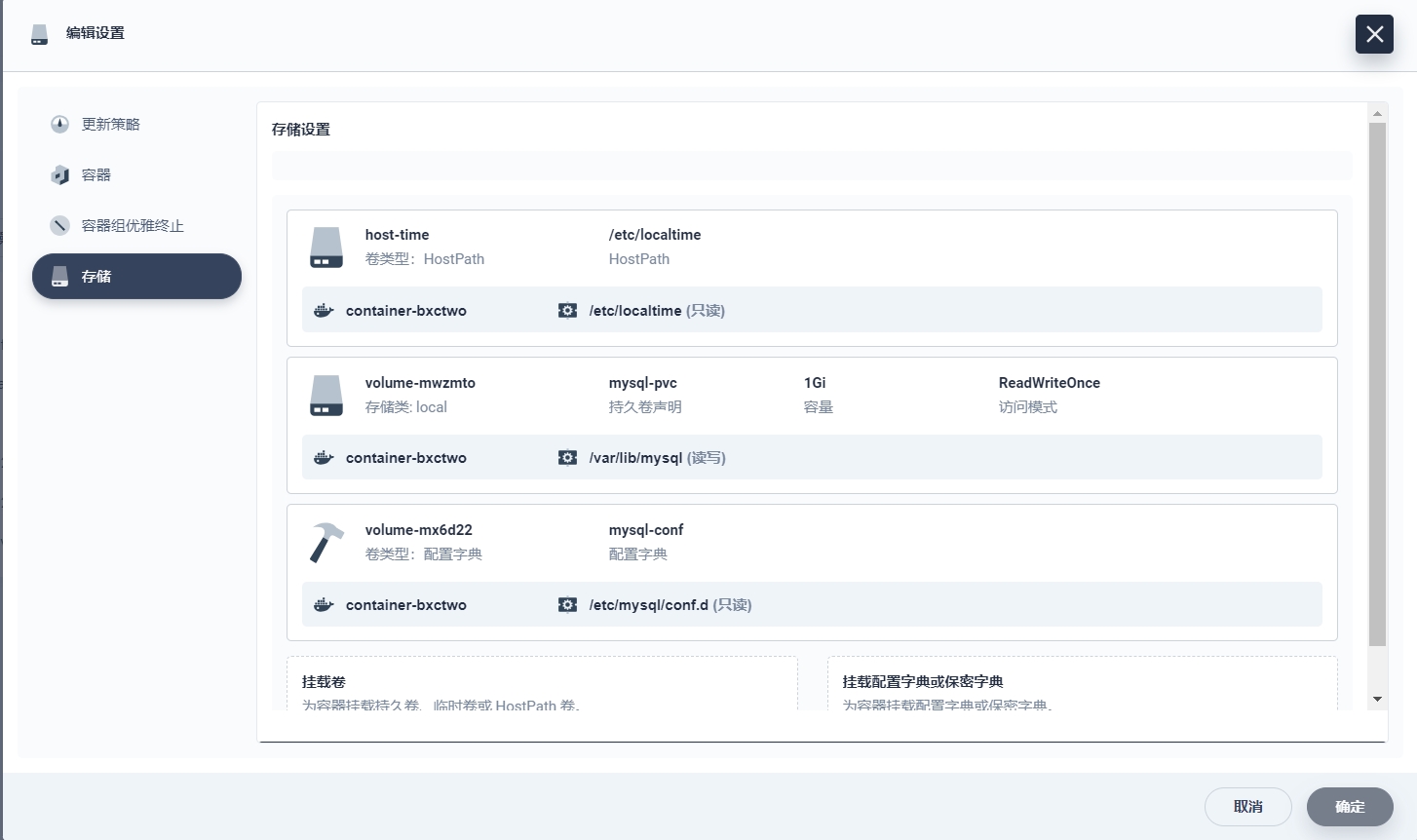
4、创建有状态副本集(deployment)
5、创建服务
服务(Service)提供一种抽象的方法,将运行在容器组(Pod)上的应用程序公开为网络服务。
- 集群内访问
- 集群外访问
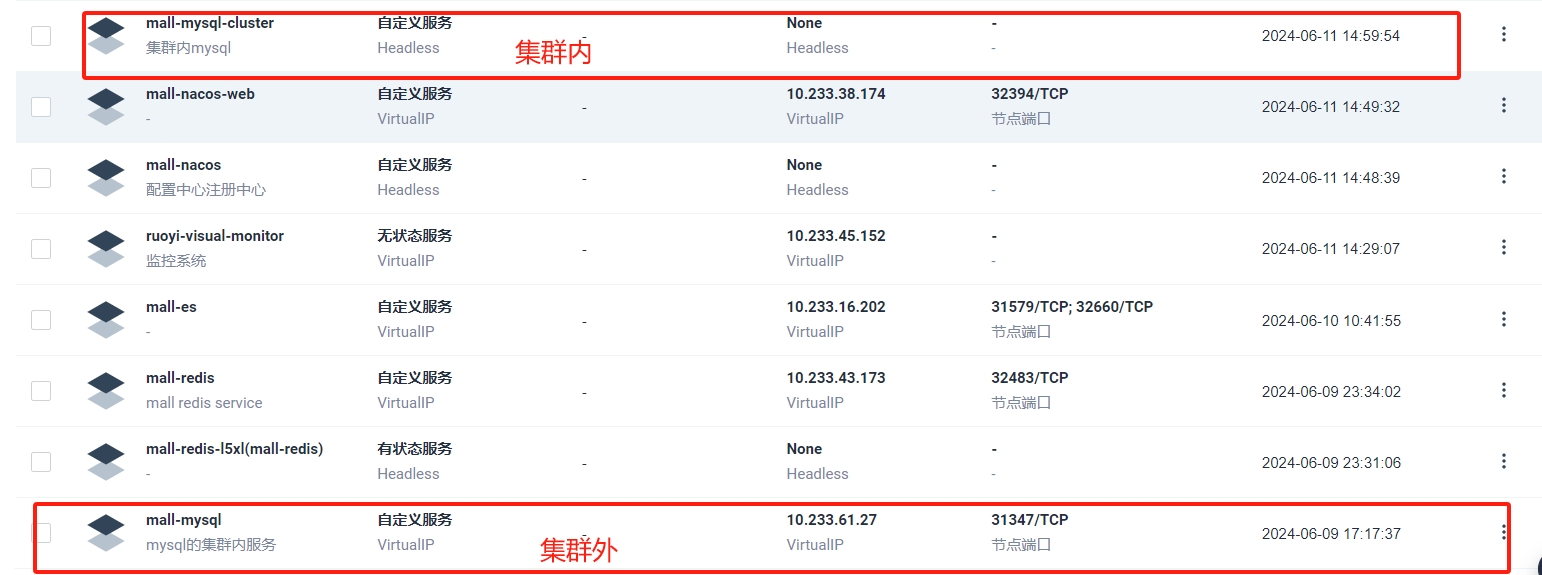
6、导入数据  数据库
数据库
- ruoyi-cloud
- ruoyi-seata
- ruoyi-config
REDIS(大部分同上)
1、创建ConfigMap(也就是配置文件)
appendonly yes
port 6379
bind 0.0.0.02、创建有状态副本集(deployment) 3、创建服务
NACOS
1、创建ConfigMap(也就是配置文件)
- application.properties
#
# Copyright 1999-2021 Alibaba Group Holding Ltd.
#
# Licensed under the Apache License, Version 2.0 (the "License");
# you may not use this file except in compliance with the License.
# You may obtain a copy of the License at
#
# http://www.apache.org/licenses/LICENSE-2.0
#
# Unless required by applicable law or agreed to in writing, software
# distributed under the License is distributed on an "AS IS" BASIS,
# WITHOUT WARRANTIES OR CONDITIONS OF ANY KIND, either express or implied.
# See the License for the specific language governing permissions and
# limitations under the License.
#
#*************** Spring Boot Related Configurations ***************#
### Default web context path:
server.servlet.contextPath=/nacos
### Include message field
server.error.include-message=ALWAYS
### Default web server port:
server.port=8848
#*************** Network Related Configurations ***************#
### If prefer hostname over ip for Nacos server addresses in cluster.conf:
# nacos.inetutils.prefer-hostname-over-ip=false
### Specify local server's IP:
# nacos.inetutils.ip-address=
#*************** Config Module Related Configurations ***************#
### If use MySQL as datasource:
### Deprecated configuration property, it is recommended to use `spring.sql.init.platform` replaced.
spring.datasource.platform=mysql
spring.sql.init.platform=mysql
### Count of DB:
db.num=1
### Connect URL of DB:
db.url.0=jdbc:mysql://mall-mysql.mall:3306/ry-config?characterEncoding=utf8&connectTimeout=1000&socketTimeout=3000&autoReconnect=true&useUnicode=true&useSSL=false&serverTimezone=UTC
db.user.0=root
db.password.0=root
### Connection pool configuration: hikariCP
db.pool.config.connectionTimeout=30000
db.pool.config.validationTimeout=10000
db.pool.config.maximumPoolSize=20
db.pool.config.minimumIdle=2
### the maximum retry times for push
nacos.config.push.maxRetryTime=50
#*************** Naming Module Related Configurations ***************#
### If enable data warmup. If set to false, the server would accept request without local data preparation:
# nacos.naming.data.warmup=true
### If enable the instance auto expiration, kind like of health check of instance:
# nacos.naming.expireInstance=true
### Add in 2.0.0
### The interval to clean empty service, unit: milliseconds.
# nacos.naming.clean.empty-service.interval=60000
### The expired time to clean empty service, unit: milliseconds.
# nacos.naming.clean.empty-service.expired-time=60000
### The interval to clean expired metadata, unit: milliseconds.
# nacos.naming.clean.expired-metadata.interval=5000
### The expired time to clean metadata, unit: milliseconds.
# nacos.naming.clean.expired-metadata.expired-time=60000
### The delay time before push task to execute from service changed, unit: milliseconds.
# nacos.naming.push.pushTaskDelay=500
### The timeout for push task execute, unit: milliseconds.
# nacos.naming.push.pushTaskTimeout=5000
### The delay time for retrying failed push task, unit: milliseconds.
# nacos.naming.push.pushTaskRetryDelay=1000
### Since 2.0.3
### The expired time for inactive client, unit: milliseconds.
# nacos.naming.client.expired.time=180000
#*************** CMDB Module Related Configurations ***************#
### The interval to dump external CMDB in seconds:
# nacos.cmdb.dumpTaskInterval=3600
### The interval of polling data change event in seconds:
# nacos.cmdb.eventTaskInterval=10
### The interval of loading labels in seconds:
# nacos.cmdb.labelTaskInterval=300
### If turn on data loading task:
# nacos.cmdb.loadDataAtStart=false
#***********Metrics for tomcat **************************#
server.tomcat.mbeanregistry.enabled=true
#***********Expose prometheus and health **************************#
#management.endpoints.web.exposure.include=prometheus,health
### Metrics for elastic search
management.metrics.export.elastic.enabled=false
#management.metrics.export.elastic.host=http://localhost:9200
### Metrics for influx
management.metrics.export.influx.enabled=false
#management.metrics.export.influx.db=springboot
#management.metrics.export.influx.uri=http://localhost:8086
#management.metrics.export.influx.auto-create-db=true
#management.metrics.export.influx.consistency=one
#management.metrics.export.influx.compressed=true
#*************** Access Log Related Configurations ***************#
### If turn on the access log:
server.tomcat.accesslog.enabled=true
### file name pattern, one file per hour
server.tomcat.accesslog.rotate=true
server.tomcat.accesslog.file-date-format=.yyyy-MM-dd-HH
### The access log pattern:
server.tomcat.accesslog.pattern=%h %l %u %t "%r" %s %b %D %{User-Agent}i %{Request-Source}i
### The directory of access log:
server.tomcat.basedir=file:.
#*************** Access Control Related Configurations ***************#
### If enable spring security, this option is deprecated in 1.2.0:
#spring.security.enabled=false
### The ignore urls of auth
nacos.security.ignore.urls=/,/error,/**/*.css,/**/*.js,/**/*.html,/**/*.map,/**/*.svg,/**/*.png,/**/*.ico,/console-ui/public/**,/v1/auth/**,/v1/console/health/**,/actuator/**,/v1/console/server/**
### The auth system to use, currently only 'nacos' and 'ldap' is supported:
nacos.core.auth.system.type=nacos
### If turn on auth system:
nacos.core.auth.enabled=false
### Turn on/off caching of auth information. By turning on this switch, the update of auth information would have a 15 seconds delay.
nacos.core.auth.caching.enabled=true
### Since 1.4.1, Turn on/off white auth for user-agent: nacos-server, only for upgrade from old version.
nacos.core.auth.enable.userAgentAuthWhite=false
### Since 1.4.1, worked when nacos.core.auth.enabled=true and nacos.core.auth.enable.userAgentAuthWhite=false.
### The two properties is the white list for auth and used by identity the request from other server.
nacos.core.auth.server.identity.key=
nacos.core.auth.server.identity.value=
### worked when nacos.core.auth.system.type=nacos
### The token expiration in seconds:
nacos.core.auth.plugin.nacos.token.cache.enable=false
nacos.core.auth.plugin.nacos.token.expire.seconds=18000
### The default token (Base64 String):
nacos.core.auth.plugin.nacos.token.secret.key=
### worked when nacos.core.auth.system.type=ldap,{0} is Placeholder,replace login username
#nacos.core.auth.ldap.url=ldap://localhost:389
#nacos.core.auth.ldap.basedc=dc=example,dc=org
#nacos.core.auth.ldap.userDn=cn=admin,${nacos.core.auth.ldap.basedc}
#nacos.core.auth.ldap.password=admin
#nacos.core.auth.ldap.userdn=cn={0},dc=example,dc=org
#nacos.core.auth.ldap.filter.prefix=uid
#nacos.core.auth.ldap.case.sensitive=true
#nacos.core.auth.ldap.ignore.partial.result.exception=false
#*************** Control Plugin Related Configurations ***************#
# plugin type
#nacos.plugin.control.manager.type=nacos
# local control rule storage dir, default ${nacos.home}/data/connection and ${nacos.home}/data/tps
#nacos.plugin.control.rule.local.basedir=${nacos.home}
# external control rule storage type, if exist
#nacos.plugin.control.rule.external.storage=
#*************** Config Change Plugin Related Configurations ***************#
# webhook
#nacos.core.config.plugin.webhook.enabled=false
# It is recommended to use EB https://help.aliyun.com/document_detail/413974.html
#nacos.core.config.plugin.webhook.url=http://localhost:8080/webhook/send?token=***
# The content push max capacity ,byte
#nacos.core.config.plugin.webhook.contentMaxCapacity=102400
# whitelist
#nacos.core.config.plugin.whitelist.enabled=false
# The import file suffixs
#nacos.core.config.plugin.whitelist.suffixs=xml,text,properties,yaml,html
# fileformatcheck,which validate the import file of type and content
#nacos.core.config.plugin.fileformatcheck.enabled=false
#*************** Istio Related Configurations ***************#
### If turn on the MCP server:
nacos.istio.mcp.server.enabled=false
#*************** Core Related Configurations ***************#
### set the WorkerID manually
# nacos.core.snowflake.worker-id=
### Member-MetaData
# nacos.core.member.meta.site=
# nacos.core.member.meta.adweight=
# nacos.core.member.meta.weight=
### MemberLookup
### Addressing pattern category, If set, the priority is highest
# nacos.core.member.lookup.type=[file,address-server]
## Set the cluster list with a configuration file or command-line argument
# nacos.member.list=192.168.16.101:8847?raft_port=8807,192.168.16.101?raft_port=8808,192.168.16.101:8849?raft_port=8809
## for AddressServerMemberLookup
# Maximum number of retries to query the address server upon initialization
# nacos.core.address-server.retry=5
## Server domain name address of [address-server] mode
# address.server.domain=jmenv.tbsite.net
## Server port of [address-server] mode
# address.server.port=8080
## Request address of [address-server] mode
# address.server.url=/nacos/serverlist
#*************** JRaft Related Configurations ***************#
### Sets the Raft cluster election timeout, default value is 5 second
# nacos.core.protocol.raft.data.election_timeout_ms=5000
### Sets the amount of time the Raft snapshot will execute periodically, default is 30 minute
# nacos.core.protocol.raft.data.snapshot_interval_secs=30
### raft internal worker threads
# nacos.core.protocol.raft.data.core_thread_num=8
### Number of threads required for raft business request processing
# nacos.core.protocol.raft.data.cli_service_thread_num=4
### raft linear read strategy. Safe linear reads are used by default, that is, the Leader tenure is confirmed by heartbeat
# nacos.core.protocol.raft.data.read_index_type=ReadOnlySafe
### rpc request timeout, default 5 seconds
# nacos.core.protocol.raft.data.rpc_request_timeout_ms=5000
#*************** Distro Related Configurations ***************#
### Distro data sync delay time, when sync task delayed, task will be merged for same data key. Default 1 second.
# nacos.core.protocol.distro.data.sync.delayMs=1000
### Distro data sync timeout for one sync data, default 3 seconds.
# nacos.core.protocol.distro.data.sync.timeoutMs=3000
### Distro data sync retry delay time when sync data failed or timeout, same behavior with delayMs, default 3 seconds.
# nacos.core.protocol.distro.data.sync.retryDelayMs=3000
### Distro data verify interval time, verify synced data whether expired for a interval. Default 5 seconds.
# nacos.core.protocol.distro.data.verify.intervalMs=5000
### Distro data verify timeout for one verify, default 3 seconds.
# nacos.core.protocol.distro.data.verify.timeoutMs=3000
### Distro data load retry delay when load snapshot data failed, default 30 seconds.
# nacos.core.protocol.distro.data.load.retryDelayMs=30000
### enable to support prometheus service discovery
#nacos.prometheus.metrics.enabled=true
### Since 2.3
#*************** Grpc Configurations ***************#
## sdk grpc(between nacos server and client) configuration
## Sets the maximum message size allowed to be received on the server.
#nacos.remote.server.grpc.sdk.max-inbound-message-size=10485760
## Sets the time(milliseconds) without read activity before sending a keepalive ping. The typical default is two hours.
#nacos.remote.server.grpc.sdk.keep-alive-time=7200000
## Sets a time(milliseconds) waiting for read activity after sending a keepalive ping. Defaults to 20 seconds.
#nacos.remote.server.grpc.sdk.keep-alive-timeout=20000
## Sets a time(milliseconds) that specify the most aggressive keep-alive time clients are permitted to configure. The typical default is 5 minutes
#nacos.remote.server.grpc.sdk.permit-keep-alive-time=300000
## cluster grpc(inside the nacos server) configuration
#nacos.remote.server.grpc.cluster.max-inbound-message-size=10485760
## Sets the time(milliseconds) without read activity before sending a keepalive ping. The typical default is two hours.
#nacos.remote.server.grpc.cluster.keep-alive-time=7200000
## Sets a time(milliseconds) waiting for read activity after sending a keepalive ping. Defaults to 20 seconds.
#nacos.remote.server.grpc.cluster.keep-alive-timeout=20000
## Sets a time(milliseconds) that specify the most aggressive keep-alive time clients are permitted to configure. The typical default is 5 minutes
#nacos.remote.server.grpc.cluster.permit-keep-alive-time=300000
## open nacos default console ui
#nacos.console.ui.enabled=true- cluster.conf
#
# Copyright 1999-2021 Alibaba Group Holding Ltd.
#
# Licensed under the Apache License, Version 2.0 (the "License");
# you may not use this file except in compliance with the License.
# You may obtain a copy of the License at
#
# http://www.apache.org/licenses/LICENSE-2.0
#
# Unless required by applicable law or agreed to in writing, software
# distributed under the License is distributed on an "AS IS" BASIS,
# WITHOUT WARRANTIES OR CONDITIONS OF ANY KIND, either express or implied.
# See the License for the specific language governing permissions and
# limitations under the License.
#
#it is ip
#example
mall-nacos-0.mall-nacos.mall.svc.cluster.local:8848
mall-nacos-1.mall-nacos.mall.svc.cluster.local:8848
- 如果想以单节点部署,则需要修改配置文件,将
cluster.conf文件删除,创建deploy的时候增加环境变量MODE=standalone
2、无状态副本集部署
com.ruoyi
├── ruoyi-ui // 前端框架 [80]
├── ruoyi-gateway // 网关模块 [8080]
├── ruoyi-auth // 认证中心 [9200]
├── ruoyi-api // 接口模块
│ └── ruoyi-api-system // 系统接口
├── ruoyi-common // 通用模块
│ └── ruoyi-common-core // 核心模块
│ └── ruoyi-common-datascope // 权限范围
│ └── ruoyi-common-datasource // 多数据源
│ └── ruoyi-common-log // 日志记录
│ └── ruoyi-common-redis // 缓存服务
│ └── ruoyi-common-seata // 分布式事务
│ └── ruoyi-common-security // 安全模块
│ └── ruoyi-common-swagger // 系统接口
├── ruoyi-modules // 业务模块
│ └── ruoyi-system // 系统模块 [9201]
│ └── ruoyi-gen // 代码生成 [9202]
│ └── ruoyi-job // 定时任务 [9203]
│ └── ruoyi-file // 文件服务 [9300]
├── ruoyi-visual // 图形化管理模块
│ └── ruoyi-visual-monitor // 监控中心 [9100]
├──pom.xml // 公共依赖基本的步骤
- 打jar包,上传服务器(maven)
- 制作镜像(dockerfile)
- 推送镜像至镜像仓库(aliyun hub)
- 应用部署(k8s)
ruoyi-auth
- 打jar包,上传服务器(maven) 直接使用maven工具打包,没啥说的
- 制作镜像(dockerfile)
FROM openjdk:8-jdk
LABEL maintainer=justin
ENV PARAMS="--server.port=9200 --spring.profiles.active=prod --spring.cloud.nacos.discovery.server-addr=mall-nacos.mall:8848 --spring.cloud.nacos.config.server-addr=mall-nacos.mall:8848
--spring.cloud.nacos.config.namespace=prod
--spring.cloud.nacos.config.file-extension=yml"
RUN /bin/cp /usr/share/zoneinfo/Asia/Shanghai /etc/localtime && echo 'Asia/Shanghai' >/etc/timezone
COPY target/*.jar /app.jar
EXPOSE 9200
ENTRYPOINT ["/bin/sh","-c","java -Dfile.encoding=utf8 -Djava.security.egd=file:/dev/./urandom -jar app.jar ${PARAMS}"]目录
docker
├── ruoyi-ui
| └── dockerfile
| └── config
| └── nginx.conf
| └── html
| └── dist
├── ruoyi-gateway
| └── dockerfile
| └── target
| └── ruoyi-gateway.jar
├── ruoyi-auth
├── ruoyi-system
├── ruoyi-visual-monitor
├── rruoyi-file
├── ruoyi-job使用docker制作镜像
docker build -t ruoyi-auth:v1 -f dockerfile .
docker tag ruoyi-gateway:v1 registry.cn-hangzhou.aliyuncs.com/justin-ruoyi/ruoyi-auth:v1- 推送镜像至镜像仓库(aliyun hub)
docker login
docker push registry.cn-hangzhou.aliyuncs.com/justin-ruoyi/ruoyi-auth:v1- 应用部署(k8s) 很简答没啥记录的
ruoyi-ui
配置文件修改vue.config.js文件
devServer: {
host: '0.0.0.0',
port: port,
open: true,
proxy: {
// detail: https://cli.vuejs.org/config/#devserver-proxy
[process.env.VUE_APP_BASE_API]: {
target: `http://ruoyi-gateway.mall:8080`, # 云网关地址
changeOrigin: true,
pathRewrite: {
['^' + process.env.VUE_APP_BASE_API]: ''
}
}
},dockerfile文件
# 基础镜像
FROM nginx
# author
MAINTAINER ruoyi
# 挂载目录
VOLUME /home/ruoyi/projects/ruoyi-ui
# 创建目录
RUN mkdir -p /home/ruoyi/projects/ruoyi-ui
# 指定路径
WORKDIR /home/ruoyi/projects/ruoyi-ui
# 复制conf文件到路径
COPY ./conf/nginx.conf /etc/nginx/nginx.conf
# 复制html文件到路径
COPY ./html/dist /home/ruoyi/projects/ruoyi-ui配置文件修改nginx.conf文件
worker_processes 1;
events {
worker_connections 1024;
}
http {
include mime.types;
default_type application/octet-stream;
sendfile on;
keepalive_timeout 65;
server {
listen 80;
server_name _;
location / {
root /home/ruoyi/projects/ruoyi-ui;
try_files $uri $uri/ /index.html;
index index.html index.htm;
}
location /prod-api/{
proxy_set_header Host $http_host;
proxy_set_header X-Real-IP $remote_addr;
proxy_set_header REMOTE-HOST $remote_addr;
proxy_set_header X-Forwarded-For $proxy_add_x_forwarded_for;
proxy_pass http://ruoyi-gateway.mall:8080/;# 网关的集群内地址
}
# 避免actuator暴露
if ($request_uri ~ "/actuator") {
return 403;
}
error_page 500 502 503 504 /50x.html;
location = /50x.html {
root html;
}
}
}上传服务器,制作镜像,推送阿里云,应用部署
ruoyi-system
ruoyi-file
ruoyi-job
ruoyi-gateway
ruoyi-visual-monitor
3、截图
阿里云镜像仓库
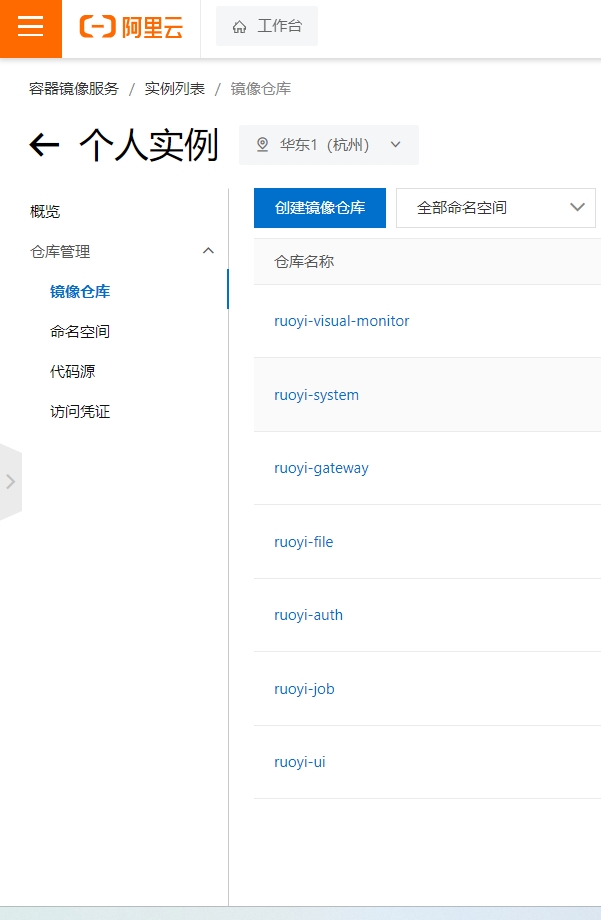
Nacos的注册中心和配置中心

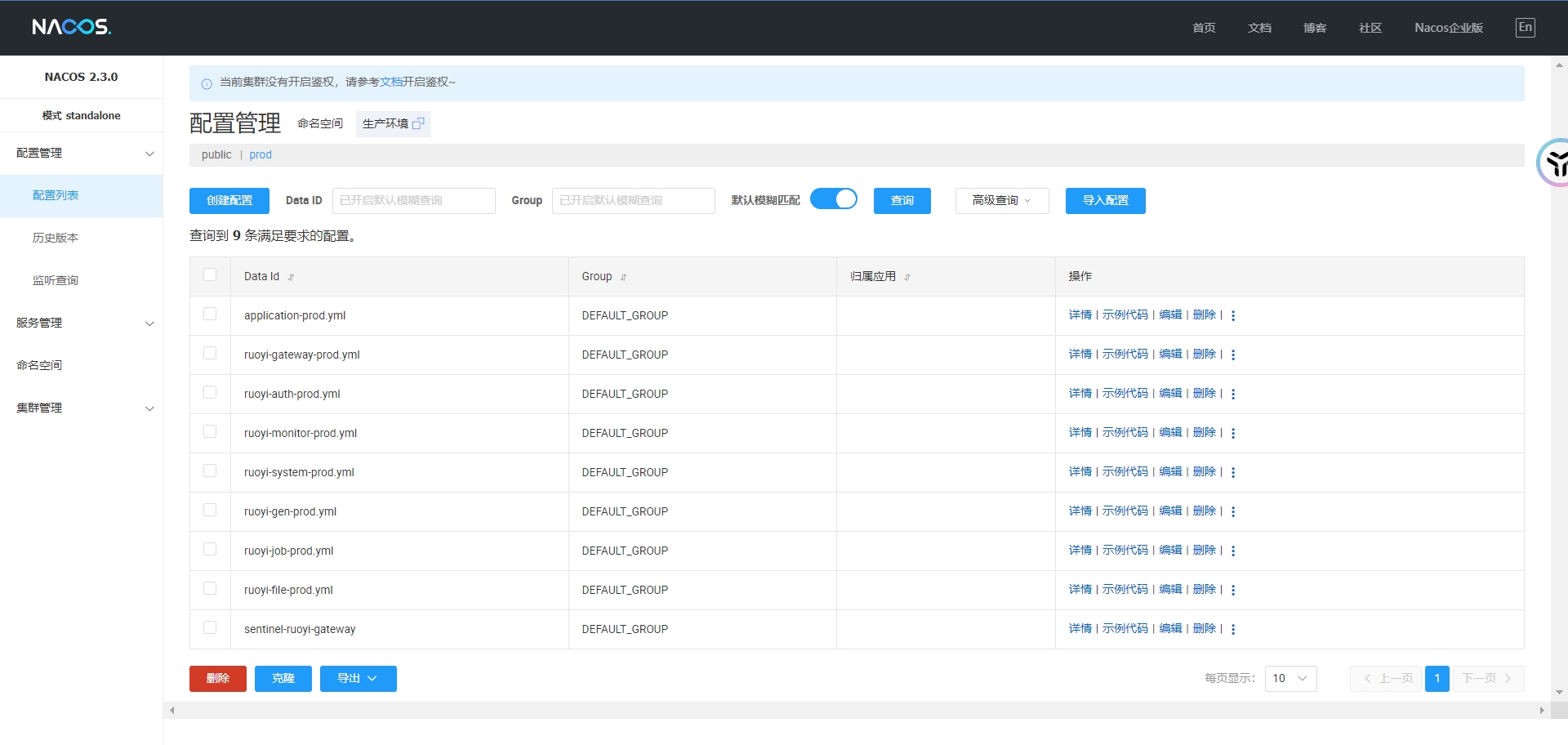
kubesphere

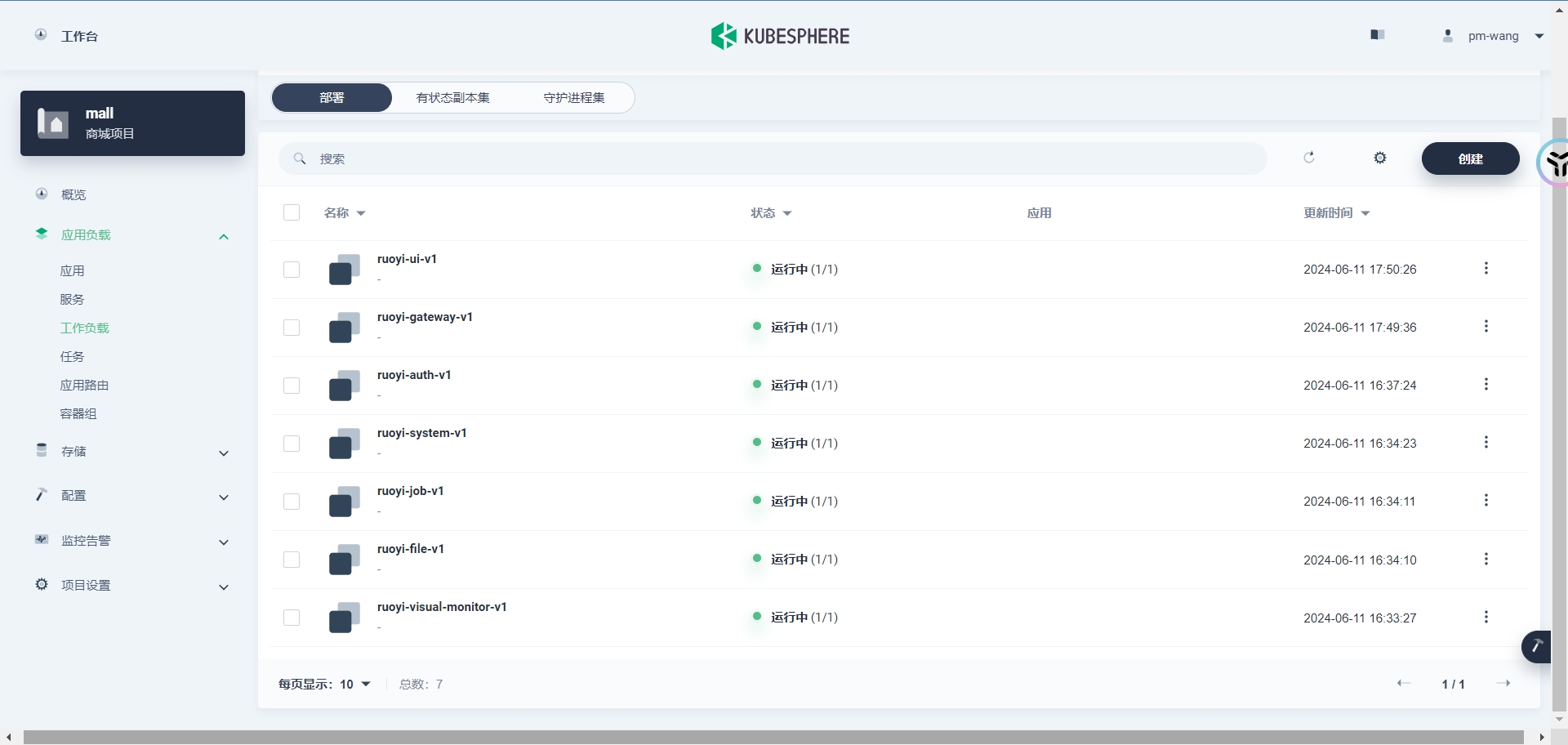
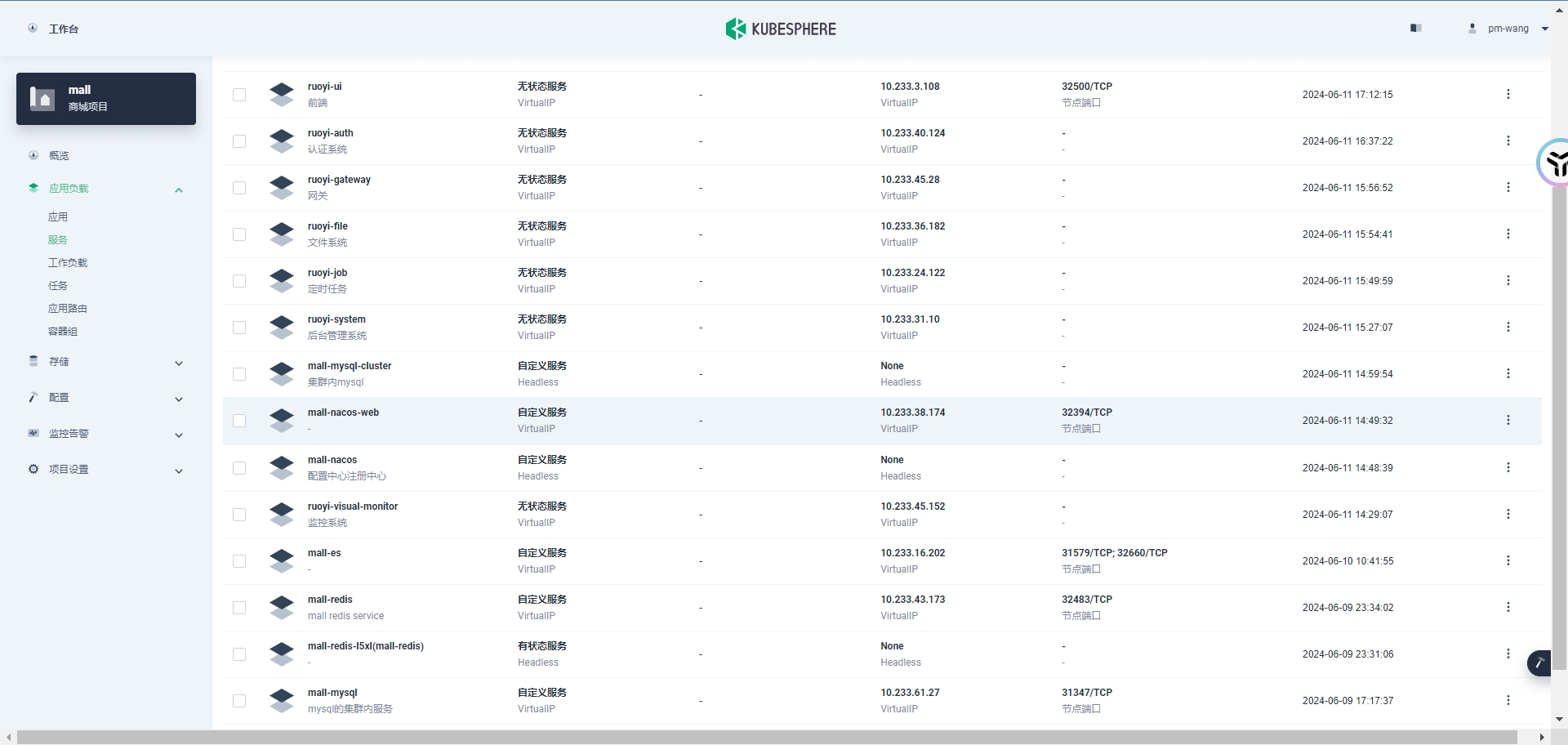
若依上云成功
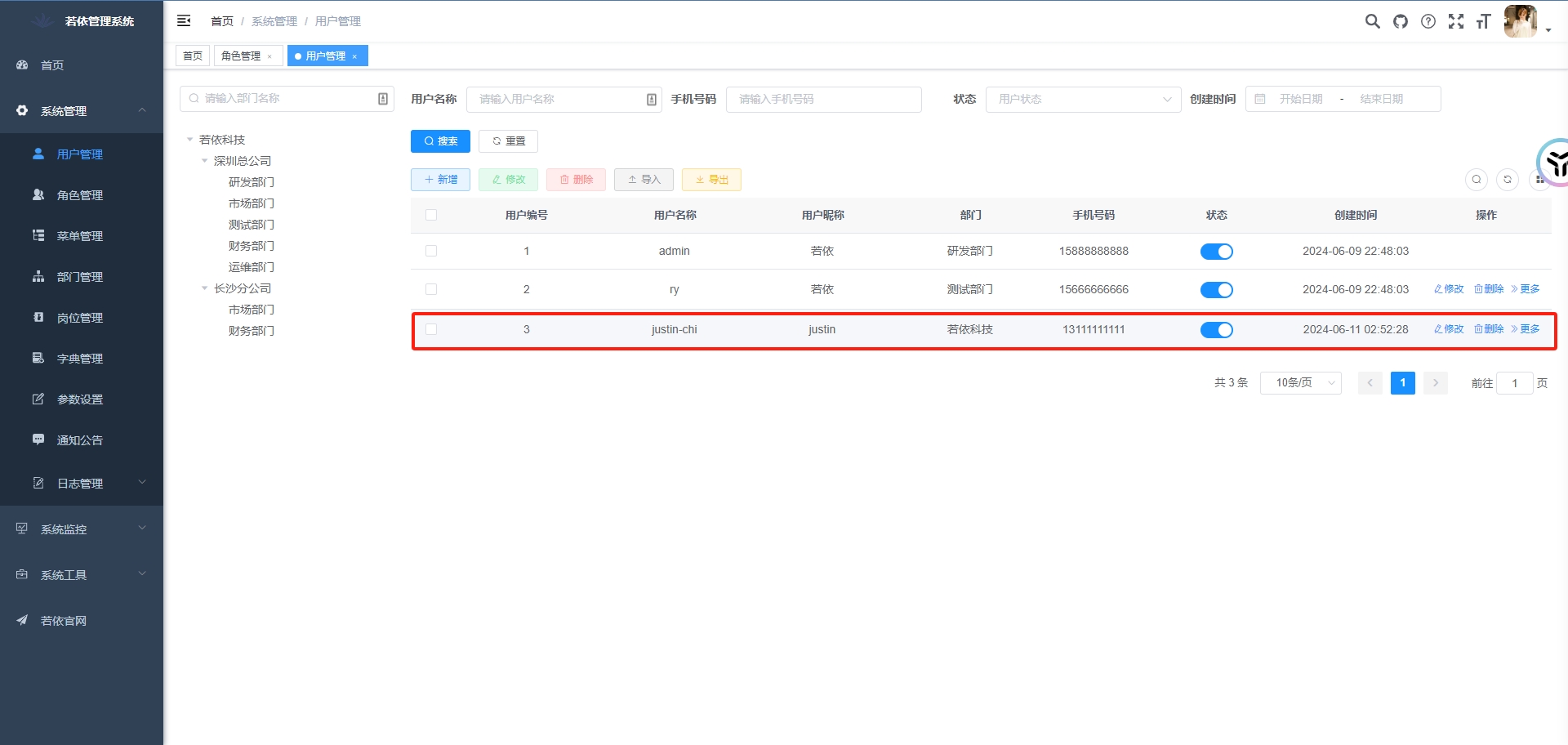
4、总结
此次上云部署遇到了很多的问题,大概说一下
问题1:kubesphere 的安装问题:
描述:
一直无法拉取相关的镜像,即使配置了阿里云的加速地址,还是无法成功,真的很头疼
解决:
自己电脑安装docker,通过科学上网的方式进行拉取,然后再上传服务器即可解决。也有可能下载不下来原因是我安装的黑苹果对网卡的兼容不是很好,所以下载失败。
docker save -o kubesphere-all-v3.1.0.tar kubespheredev/ks-installer:v3.1.0
docker load -i kubesphere-all-v3.1.0.tar问题2:资源不足
描述:
在部署微服务的时候 0/1 nodes are available: 1 Insufficient cpu.,0/1 nodes are available: 1 Insufficient memory.出现这个问题导致部署失败
解决:
因为我是用的是虚拟机,并且使用All-in-One模式安装kubesphere,只有单节点,没有部署集群模式,所以在后期部署的时候不是cpu不够就是内存不够,还有硬盘不足,幸好另一台电脑是16G+1t,只能继续给虚拟机加资源了。所以在部署前还是要有一定的规划的。虽然此次的中间件和微服务不算多,也用掉了7G多一点。

问题3:前端ruoyi-ui
描述:
部署完成之后,浏览器总是报错内部服务错误,验证码也不显示。
解决:
观看ruoyi-ui的日志,没有发现什么错误,然后转念一想发请求首先会通过ruoyi-gateway网关,那么我去看了一下他的日志,果然找到了问题。
17:13:15.897 [reactor-http-epoll-2] ERROR c.r.g.h.GatewayExceptionHandler - [handle,52] - [网关异常处理]请求路径:/code,异常信息:Unable to connect to Redis; nested exception is io.lettuce.core.RedisConnectionException: Unable to connect to localhost:6379错误提示是说无法连接redis,并且无法访问localhost:6379,所以问题出在redis上,我查看了ruoyi-gateway的配置文件,发现redis配置正确啊,并没有什么localhost:6379,此时就卡住了。喝了口水之后,想了一下到底哪里出问题了,ruoyi-ui没问题,gateway连接redis没有问题,那我重新将gateway副本减为0,重新部署一下,成功了。就很奇怪,可能是我修改了配置文件后,没有重新部署,所以才出问题。
问题4:服务器重启,微服务失败
描述:
机器重启后,微服务一部分失败,微服务连接nacos失败,nacos日志No Datasource set,主要就是数据库没有准备好,nacos连接数据失败,从而导致微服务启动失败。
解决:
等待mysql启动成功,然后nacos重新启动,最后微服务启动即可。 k8s健康检查机制:
- livenessProbe:存活探针,用于检测应用是否存活,如果应用存活则继续运行,否则重启应用。
- readinessProbe:就绪探针,用于检测应用是否就绪,如果应用就绪则允许接收请求,否则拒绝请求。
- startupProbe:启动探针,用于检测应用是否启动完成,如果应用启动完成则继续运行,否则重启应用。
